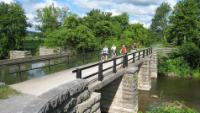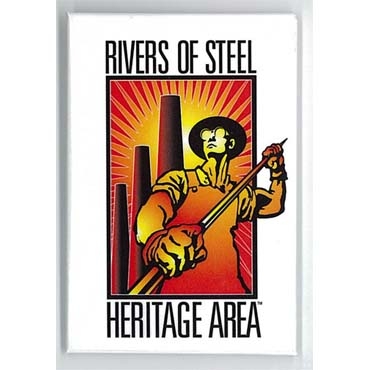Creating and implementing programs to jump start community and economic development is never easy and to do so on a landscape scale might seem doubly difficult. However, there are good reasons why it is worth a try.

Corridor.
One element is the benefit of working at scale. Small rural communities simply cannot afford to develop plans and impactful promotional campaigns. Most do not have a critical mass of dining, lodging and attractions to attract and retain sufficient number of visitors. And in some cases, the draw is actually regional in nature, for example a long-distance trail, canal system, or large block of natural areas.
More urbanized regions can also benefit from a landscape perspective, particularly if they wish to focus on a single heritage topic such as the city’s industrial past. In these places, it can be instructive to link seemingly disparate places together by connecting the sites of production, with transportation links, as well as the communities that housed and supported its workers.
These efforts are particularly beneficial in non-metropolitan areas where small business jobs account for 42% of employment (Brooking Institution). This is a winning strategy for smaller communities as those small businesses are predominately in local ownership and more of the dollars generated stay in the the local economy. According to the National Main Street Center between 2015 and 2019, U.S. towns with populations of 25,000 or less invested more than $20 billion in public and private funds in their downtown cores. These businesses created approximately 106,000 net new full-time and 25,000 net new part-time jobs. Now imagine if you invest on a regional basis in multiple small towns. The impact could be significant. So let’s look at a few case studies.
PA Wilds
One of the most ambitious and now long running efforts in landscape scale rural development is the PA Wilds launched in 2003. The initiative was centered on a rural region in northern Pennsylvania that is known for its heritage of public lands and small historic communities. External forces like globalization have caused a decrease in jobs followed by high unemployment rates and population loss with the sharpest decline in the numbers of younger, working-age residents. But the region also had assets – such as 2 million acres of protected land, including 29 state parks, 8 state forests, and the Allegheny National Forest – one of the largest blocks of public land on the east coast equivalent in size to Yellowstone National Park.
Initially, the PA Wilds focused on outdoor tourism to expand the recreational amenities on these lands, which would increase visitation and lead to economic revitalization The PA Wilds strategy included a new brand name, promotional campaigns, and major investment in public recreational facilities. However, community redevelopment especially on a landscape scale is more complex than just heads in beds. And that is why the work of Ta Enos the CEO and Founder of the PA Wilds Center for Entrepreneurship is so important. Her job is to diversify the regional economy by building on local products and industries. The program has expanded from artists and craftsmen to include craft winemakers and distillers. Enos sees local food products as an exciting future branding opportunity. Creating this more complex local economy is critical to the future of small towns. The PA Wilds is hoping to build a network using culture and nature to create sustainable communities framed by forests and public lands. Read a recent interview with Ta Enos here.
Rivers of Steel

Working on a regional or landscape scale can be an effective economic development strategy in urbanized regions as well as rural localities. A recently released economic impact report for the Rivers of Steel National Heritage Area documented more than $92 million of economic benefit and 922 jobs each year as a result of spending by visitors to Rivers of Steel and its partners. The Rivers of Steel is an eight-county area in western Pennsylvania that recognizes the historic legacy of steelmaking in the region from blast furnaces to worker housing and by telling stories from labor strife to industrial innovation. For over 25 years, the heritage area has invested in restoring National Historic Landmarks like the Carrie Blast Furnaces and the Bost Building in Homestead to reconnecting visitors and residents to the region’s iconic three rivers with trails and riverboat excursions. The work of the Rivers of Steel recasts a former industrial landscape into a postindustrial asset. August Carlino, President and CEO of Rivers of Steel, said the study demonstrates that both state and federal heritage area program “are true economic drivers and worthy of the investments of the public and private sectors.”
Erie Canal
Another repurposing of an industrial landscape is a recent proposal to reimagine the storied Erie Canal in New York State. Originally completed in nineteenth century as the gateway to the west, it has been updated over the years. However, today the canal’s commercial usage is almost negligible. The proposal issued in 2019, seeks to find other uses for the canal and assist in economic development of adjacent communities through recreation and tourism. The first phase of the effort, a $100 million economic development fund, will support projects that adaptively reuse canal infrastructure to enhance water based recreation, tie the Canal’s new recreational improvements to the Governor’s Empire State Trail, celebrate historic canal structures, and develop unique canal side attractions and activities. The canal’s National Heritage Area status will provide a unified interpretive framework.
What is Next?
Embracing these efforts to revitalize regional economies on a landscape scale has never been more critical. The pandemic has wreaked havoc on the nation’s small businesses and its main streets that employ 60 million Americans (about 50% of the entire US workforce). Despite being the nation’s largest employers, these businesses generally operate on the narrowest of margins. Closure orders, the reluctance of consumers to travel, eat out, or shop in person, and a growing economic downturn, will continue to negatively impact these economic drivers of small towns, rural areas, and rust belt communities. For many communities their economic recovery will depend on even more coordinated and well-funded redevelopment efforts. In a recent article, The US Government needs to save Main Street not just Wall Street, Dennis Keleher examines the fragmented nature of federal community assistance programs to small business. Financial grants and loans are spread between the Department of Commerce, Treasury, and now the Federal Reserve. Essential employee welfare programs are found elsewhere. He proposes a new Department of Economic Security to gather together these ‘underfunded, uncoordinated and ineffective assortments of programs’.
While creating more government departments may not be the best answer, something needs to be done. Perhaps a better idea would be a purposeful sweep to identify and promote the most innovative regional development ideas that are found in such unlikely places as the Department of the Interior – the National Heritage Areas – and in the Department of Agriculture – Rural Development programs. And let’s not to forget programs at the state level and outside of government like the National Main Street Center. These approaches could then be matched up with the above-mentioned sources of financial assistance for a much more effective outcome. The Appalachian Regional Commission was an experiment in doing just this on a large enough landscape. However, it does not have a mandate to reach outside its authorized programs and coordinate a rescue effort that is both big enough and yet focused on the grassroots level. Again, these are only the glimmer of a solution, but for the sake of the marginalized parts of our nation, let me repeat myself, something needs to be done.


